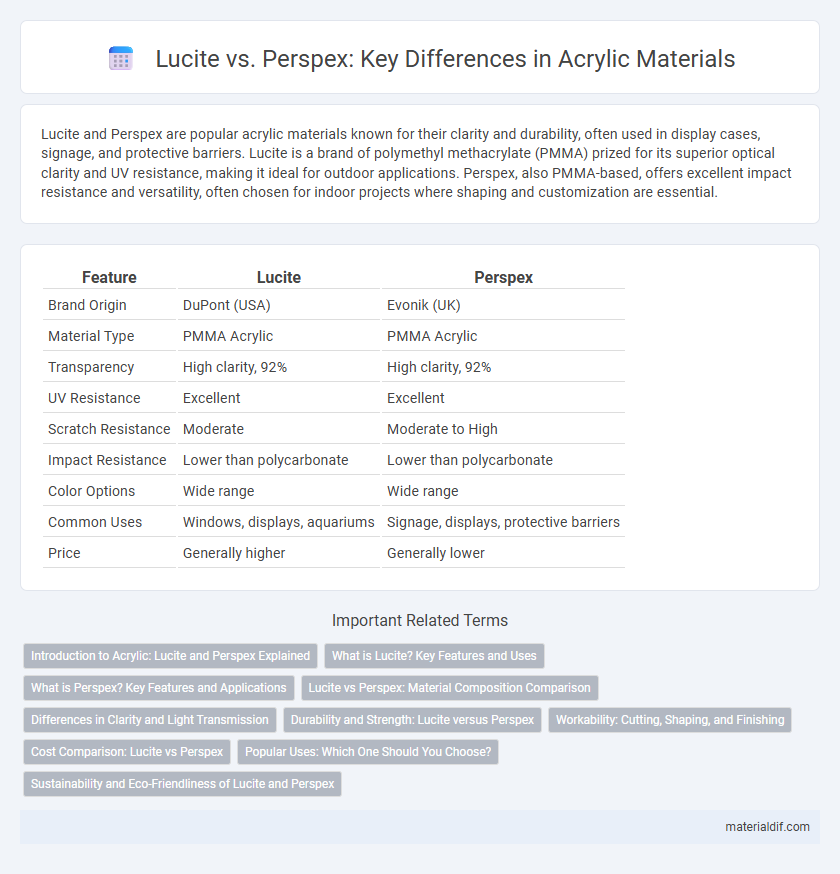Lucite and Perspex are popular acrylic materials known for their clarity and durability, often used in display cases, signage, and protective barriers. Lucite is a brand of polymethyl methacrylate (PMMA) prized for its superior optical clarity and UV resistance, making it ideal for outdoor applications. Perspex, also PMMA-based, offers excellent impact resistance and versatility, often chosen for indoor projects where shaping and customization are essential.
Table of Comparison
| Feature | Lucite | Perspex |
|---|---|---|
| Brand Origin | DuPont (USA) | Evonik (UK) |
| Material Type | PMMA Acrylic | PMMA Acrylic |
| Transparency | High clarity, 92% | High clarity, 92% |
| UV Resistance | Excellent | Excellent |
| Scratch Resistance | Moderate | Moderate to High |
| Impact Resistance | Lower than polycarbonate | Lower than polycarbonate |
| Color Options | Wide range | Wide range |
| Common Uses | Windows, displays, aquariums | Signage, displays, protective barriers |
| Price | Generally higher | Generally lower |
Introduction to Acrylic: Lucite and Perspex Explained
Lucite and Perspex are two prominent brand names representing acrylic, a versatile transparent thermoplastic known for its clarity and durability. Lucite, developed by DuPont, is renowned for its excellent UV resistance and high optical clarity, making it ideal for outdoor and display applications. Perspex, created by ICI, offers similar strength and transparency, with a slightly enhanced impact resistance, often favored in signage and architectural uses.
What is Lucite? Key Features and Uses
Lucite is a high-quality brand of acrylic known for its exceptional clarity, UV resistance, and durability, commonly used in lighting fixtures, automotive parts, and jewelry. It offers superior weatherability and impact resistance compared to standard acrylic, making it ideal for outdoor applications and artistic displays. Key features include excellent light transmission, ease of fabrication, and polishability, ensuring versatile use across both commercial and decorative projects.
What is Perspex? Key Features and Applications
Perspex is a brand of acrylic known for its excellent transparency, weather resistance, and UV stability, making it ideal for outdoor signage, display cases, and glazing applications. Its lightweight and shatter-resistant properties offer a safer alternative to glass while maintaining high optical clarity. Perspex sheets are also commonly used in automotive components, aquariums, and architectural designs due to their versatility and durability.
Lucite vs Perspex: Material Composition Comparison
Lucite and Perspex, both acrylic brands, differ primarily in their polymer formulations and manufacturing processes; Lucite is a trademarked polymethyl methacrylate (PMMA) produced by Arkema, known for its superior optical clarity and UV resistance. Perspex, manufactured by Evonik, offers a slightly different PMMA blend that emphasizes impact resistance and surface hardness. This variation in material composition results in distinct performance characteristics, making Lucite preferable for high-end optical applications and Perspex more suitable for durable, everyday use.
Differences in Clarity and Light Transmission
Lucite offers exceptional clarity with a light transmission rate of approximately 92%, making it ideal for applications demanding superior optical performance. Perspex, while still clear, has a slightly lower light transmission rate near 88%, which can affect visual sharpness in certain uses. The difference in clarity and light transmission between Lucite and Perspex stems from their distinct manufacturing processes and polymer compositions, influencing their suitability for high-precision optical applications.
Durability and Strength: Lucite versus Perspex
Lucite and Perspex are both high-quality acrylic brands known for excellent durability and strength, with Lucite often praised for its superior clarity and impact resistance. Perspex offers robust performance with slightly greater resistance to UV damage and weathering, making it ideal for outdoor applications. Both materials outperform standard acrylic in toughness and longevity, but Lucite tends to provide enhanced scratch resistance and overall durability in demanding environments.
Workability: Cutting, Shaping, and Finishing
Lucite and Perspex both excel in workability, offering smooth cutting and precise shaping capabilities ideal for detailed projects. Lucite tends to have a slightly higher clarity and chemical resistance, making it easier to finish with polished, scratch-resistant surfaces. Perspex, known for its superior impact resistance, provides greater flexibility during shaping and sanding, ensuring durable and clean edges in fabrication.
Cost Comparison: Lucite vs Perspex
Lucite typically costs more than Perspex due to its superior optical clarity and higher manufacturing standards. Perspex offers a more budget-friendly option while maintaining good durability and versatility for various applications. Choosing between Lucite and Perspex hinges largely on balancing cost-efficiency with specific quality requirements.
Popular Uses: Which One Should You Choose?
Lucite and Perspex are both popular acrylic brands commonly used in signage, displays, and protective barriers due to their clarity and durability. Lucite is favored in high-end applications like aquariums and furniture where optical clarity is crucial, while Perspex is often chosen for outdoor signs and architectural features because of its superior UV resistance. Selecting between Lucite and Perspex depends on specific project needs, especially considering factors like exposure to sunlight and desired aesthetic quality.
Sustainability and Eco-Friendliness of Lucite and Perspex
Lucite and Perspex are both acrylic brands, but Lucite stands out for its commitment to sustainability by using 100% recyclable materials and incorporating post-consumer recycled content. Perspex, while also recyclable, often relies more on virgin acrylic production processes that consume greater energy and resources. Lucite's eco-friendly manufacturing reduces carbon footprint and supports circular economy principles, making it a preferred choice for environmentally conscious projects.
Lucite vs Perspex Infographic

 materialdif.com
materialdif.com